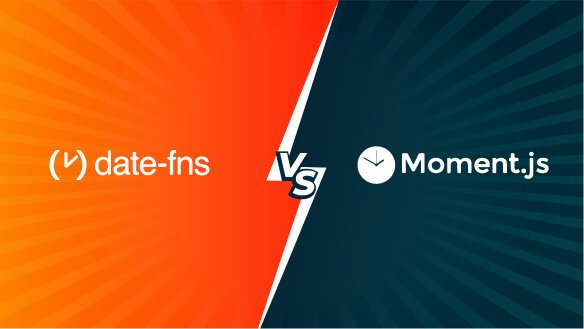
Working with dates in JavaScript can feel like navigating a tangled knot of time zones, formats, and inconsistencies. Enter libraries like Moment.js and date-fns, valiant knights offering tools to parse, format, and manipulate dates with ease. But which champion should you choose?
This blog post delves into the fascinating battle between these two libraries, highlighting the strengths of date-fns and providing clear comparisons to empower you to make the best decision for your project. We'll explore their philosophies, features, and performance, ultimately revealing why date-fns might be the modern choice for your date-wrangling needs.
Imagine a time before smartphones and fancy calendars. Back then, Moment.js emerged as a knight in shining armor, simplifying how we handled dates in JavaScript. Its core features became legendary:
For years, Moment.js reigned supreme, with a large and loyal following praising its versatility and power. But like all empires, things evolve...
While Moment.js held the fort for years, a new challenger has emerged: date-fns. This modern library approaches date handling with a different philosophy, offering distinct advantages:
Modular Mastery: Forget bulky toolkits! date-fns provides individual functions for each task, like a well-equipped workbench. Need to format a date? Grab the "format" function. Add days? Use "addDays". This focused approach reduces the code you import, keeping your bundle size lean and your app lightning-fast.
Immutable Guardian: Ever accidentally mutate a date and cause chaos? Not with date-fns! It follows the principle of immutability, meaning it never changes the original date. This ensures predictable behavior and makes reasoning about your code much easier. No more hidden side effects to worry about!
Tree-Shaking Prowess: Modern build tools like Webpack can eliminate unused code from your final bundle. date-fns is built with this in mind, allowing tree-shaking to further reduce its size. This is especially beneficial for large projects where every byte counts.
Worldwide Hero: The world is diverse, and dates should be too! date-fns boasts support for over 50 locales out of the box. This means you can easily format dates and times according to different languages and regions, making your app truly internationalizable.
TypeScript's Best Friend: If you're a TypeScript user, you'll be happy to know that date-fns has built-in type definitions. This enhances code clarity and improves maintainability by providing type information for all its functions. Writing and understanding your date-related code becomes a breeze!
With these powerful features, date-fns stands as a compelling alternative to Moment.js, especially for modern JavaScript projects that prioritize performance, modularity, and internationalization. Stay tuned as we delve deeper into a side-by-side comparison to see which champion truly reigns supreme!
Now that we've met our contenders, let's put them under the spotlight! Here's a side-by-side comparison of their key features:
| Feature | Moment.js | date-fns |
|---|---|---|
| API Style | Object-oriented | Function-based |
| Immutability | Mutable | Immutable |
| Bundle Size | Larger | Smaller |
| Performance | Slower (due to size) | Faster |
| Tree-shaking | Not optimized | Compatible |
| Locale Support | Broader | Extensive |
| TypeScript Support | Available (plugin) | Built-in |
API Style:
Immutability:
Bundle Size:
Performance:
Tree-shaking:
Locale Support:
TypeScript Support:
Remember, the "best" library depends on your specific needs and priorities. This comparison aims to highlight the key differences to help you make an informed decision!
Now, let's see these libraries in action! We'll tackle common tasks like formatting, parsing, and manipulating dates to compare their approaches:
Moment.js:
const moment = require('moment');
const myDate = new moment();
const formattedDate = myDate.format('MMMM Do YYYY, h:mm a');
console.log(formattedDate); // Output: February 19th 2024, 02:09 pm
date-fns:
import format from 'date-fns/format';
const myDate = new Date();
const formattedDate = format(myDate, "MMMM Do YYYY, h:mm a");
console.log(formattedDate); // Output: February 19th 2024, 02:09 pm
Notice: Both libraries achieve the same result, but date-fns uses a simpler import and a more declarative format string.
Moment.js:
const dateString = '2024-02-23';
const parsedDate = moment(dateString);
console.log(parsedDate.format('DD-MM-YYYY')); // Output: 23-02-2024
date-fns:
import parse from 'date-fns/parse';
const dateString = '2024-02-23';
const parsedDate = parse(dateString, 'yyyy-MM-dd', new Date());
console.log(format(parsedDate, 'DD-MM-YYYY')); // Output: 23-02-2024
Notice: Similar outcome, but date-fns requires specifying the format and providing a base date for parsing.
Moment.js:
const myDate = new moment();
const futureDate = myDate.add(7, 'days');
console.log(futureDate.format('YYYY-MM-DD')); // Output: 2024-02-26
date-fns:
import addDays from 'date-fns/addDays';
const myDate = new Date();
const futureDate = addDays(myDate, 7);
console.log(format(futureDate, 'YYYY-MM-DD')); // Output: 2024-02-26

Let's collaborate to turn your business challenges into AI-powered success stories.
Get Started